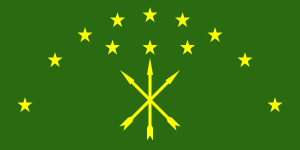Flag of Adygea
The flag of the Republic of Adygea, a federal subject of Russia, has a green field charged with twelve gold stars, nine forming an arc and three horizontal. It is also charged with three crossed arrows in the center. The green color rgb values (5 63 13), and the gold colors rgb values (189 166 98). The Scot David Urquhart (1805-1877), then serving on the staff of the British Embassy in Constantinople, allegedly designed the flag in 1836.[1][2]
 | |
| Proportion | 1:2 |
|---|---|
| Adopted | March 24, 1992 (designed in 1830) |
| Design | Twelve golden stars resembling a bow with three golden arrows on a green background |
| Designed by | David Urquhart |
The green represents the forests and vegetation of the Caucasus. The twelve stars symbolize the individual tribes of Adygea; the nine stars within the arc symbolize the nine aristocratic tribes of Adygea, in contrast to the three horizontal stars which symbolize the three democratic tribes. The arrows symbolize peace. The gold colors of the arrows and stars represent the plentiful harvest of grain and wheat.
The original design of the flag was drawn in 1830 by prince Sefer Bey Zanuko and was hand-delivered by the British delegate James Stanislaus Bell to the Adyghe Nour Mohamed Hag'ur in Gesh Valley (present-day Sochi) where it flew for the first time to cheers from Adyghe princes and a multitude of people. The Adyghe people used this design in the 19th-century fight against the Russian Empire. The Republic of Adygea adopted the present-day flag in a law of March 24, 1992. The proportions are 2:1.
This flag reflects and revives the unity of the Adyghe Nation in Circassia; besides the Adyghes in the Republic of Adyghea, it also represents the Kabardians in Kabardino-Balkaria, the Cherkess (Adyghe: Шэрджэс) in Karachay–Cherkessia, and the Shapsugs in the southern part of Krasnodar Krai, plus small Adyghe groups in Stavropol Krai and North Ossetia.
References
-
Richmond, Walter (2013). "A Pawn in the Great Game". The Circassian Genocide. Genocide, Political Violence, Human Rights. New Brunswick, New Jersey: Rutgers University Press. p. 50. ISBN 9780813560694. Retrieved June 10, 2019.
[...] Urquhart claims to have met fifteen tribal leaders and nearly two hundred village chiefs, designed the Circassian flag, and helped them draft a petition to London for assistance.
-
Bashqawi, Adel (2017). "The Circassian Flag, the Homeland, the Circassian Identity". Circassia: Born to Be Free. Xlibris Corporation. ISBN 9781543447651. Retrieved June 10, 2019.
In other narratives about the construction of the Circassian flag, the green flag contains twelve golden stars and three golden crossed arrows pointing upwards, which was originally created when a number of tribes agreed on a union in the 1830s and the flag was designed and drawn by the Scotsman David Urquhart during that same period.